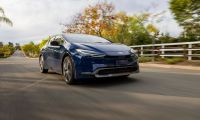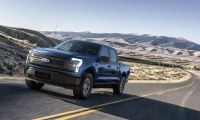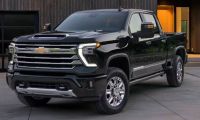New hybrid information has surfaced.
Let's delve into the details of Subaru's new hybrid trim levels. The four new Subaru Hybrid SUVs that are on the horizon will pique customers' interest. While I've covered the Forester hybrid in recent reports, new information has surfaced about the hybrid technology it will feature, including its unique features, specifications, and performance capabilities.
The next-generation Forester Hybrid will not be a PHEV.
I recently discovered that the Forester's hybrid system will not be a plug-in hybrid system (PHEV) like the discontinued Crosstrek Hybrid. The next-generation Forester hybrid will have a standard hybrid powertrain.
Some of the information in this report comes from a source close to Subaru. Other information here comes from Tetsuo Fujinuki, Subaru's chief technical officer.
Subaru's Boxer and AWD
Fujinuki says, "Subaru's Boxer engine configuration and Symmetrical all-wheel drive system are the brand's two hallmarks and the main reasons customers are drawn to our cars, making their retention in its new hybrids crucial going forward."
Subaru's hybrid is an all-in-one system.
Subaru's new hybrid technology formula is straightforward, according to Fujinuki. The all-new Forester hybrid will retain the Japanese automaker's signature horizontally opposed Boxer engine and employ it as a generator and drive unit. Fujinuki says it's a series-parallel hybrid system similar to the Toyota Prius, making it easy to understand and use.
He says the new series-parallel hybrid powertrain, not Plug-in hybrid technology, will package Subaru's internal combustion Boxer engine, electric motor, transfer case, and transmission together at the front of the vehicle. A drive shaft will stretch back to a small rear differential to power the all-wheel drive system.
The power control unit sits on top of the configuration, freeing up room at the vehicle's rear for a traditional-sized fuel tank. With the hybrid system and full-sized fuel tank, they've achieved a more extended range of gas and electric propulsion with the vehicle.
The hybrid system will send power to the wheels via a transaxle instead of the traditionally favored continuous variable transmission (CVT) setup used on all Subaru vehicles now.
The Subaru hybrid system will be designed and manufactured later this year at its newly renovated factory in Japan's Kitamoto City. The factory previously made general-purpose engines for the Japanese automaker. Check my report here for more information.
When will the new Forester Hybrid be available for customers?
The next-generation Forester hybrid will arrive late next summer, 2025.
An all-new Subaru Crosstrek Hybrid will be coming soon after the Forester Hybrid. The Crosstrek is not a plug-in hybrid; it will also have a standard hybrid powertrain similar to the Forester.
When will the Crosstrek Hybrid be available for customers?
The new Crosstrek Hybrid will likely arrive in North America in early 2026.
The next-generation Subaru Outback Hybrid is coming later.
The redesigned Subaru Outback will likely see a hybrid trim level after the Crosstrek. It will come with the next-generation Outback remodel launch in 2026. The new Outback will also have a standard hybrid powertrain similar to the Forester and Crosstrek technology.
When will the Outback Hybrid make its U.S. launch?
The new Outback Hybrid should be available in 2027 after the new model launch in North America.
The next-generation Outback will get new upgrades over the current generation model.
Outback will get newly revamped seats that are more comfortable.
The 2026 Outback will have the new EyeSight technology with an updated three-camera system that offers improved vehicle, pedestrian, and bicycle detection.
Look for a new front end and grille design.
The newly remodeled Outback will be available in spring 2025. So expect an announcement from Subaru before the end of this year. Stay tuned.
A new Ascent 3-Row SUV hybrid
The next-generation Ascent family hauler has been delayed due to Subaru's decision to wait and determine the future emissions standards in the U.S. over the next four years. This delay is contingent on the results of the U.S. Presidential election, which could significantly impact the automotive industry's regulatory landscape.
There are two options that Subaru Corporation could take with Ascent.
The gasoline-powered Ascent three-row could be replaced in the lineup by a new three-row EV built in Kentucky in collaboration with Toyota. Alternatively, it may follow the Forester and Outback and remain for another generation with an optional hybrid powertrain. Read more in my report here.
A report from Automotive News (by subscription) says that if Subaru decides to drop the gas-powered Ascent, the new 3-Row EV developed by Toyota may assume the Ascent name. (depending on election results).
Automotive News said the all-new Subaru 3-Row EV will be built on the e-Subaru Global Platform and use batteries supplied from Toyota's plant, which is under construction in Liberty, North Carolina.
Why did Subaru choose a standard hybrid powertrain over a plug-in technology for its next-generation hybrid SUVs?
The conventional hybrid does not require an external charging source. The PHEV does need to be "plugged in" to take advantage of the hybrid fuel efficiency. A source close to Subaru says many customers did not use the plug-in technology on the Crosstrek PHEV.
Subaru received feedback from current Crosstrek Plug-In Hybrid model customers who said they didn't use the plug-in benefit. So, Subaru will offer its new hybrid models with lower-cost, standard hybrid options.
There are three reasons why Subaru chose the standard hybrid.
1. There is a significantly lower upfront cost for the customer when purchasing the hybrid vehicle.
2. It's more convenient because you don't have to recharge the battery to use electric power.
3. It's much easier for the customer to transition from a gas-engine vehicle to a hybrid model. You drive the hybrid vehicle and take advantage of the improved fuel efficiency.
And there were other issues.
The Crosstrek PHEV only had a 17-mile range, and many customers did not have a charger at home and didn't even use the plug-in option. So, they paid significantly more upfront in cost and didn't get the hybrid benefits.
The 2023 Crosstrek Hybrid had a starting price of $38,070, which included destination and delivery fees ($1,225). A 2023 Subaru Crosstrek Premium trim forehead had an MSRP of $26,020, including dealer fees, which was $12,050 less than the Hybrid trim level.
And there was the issue of availability.
One of the problems with the Crosstrek Plug-In Hybrid was that it was only available in certain U.S. states with stricter regulations on emissions. Subaru won't make the same mistake with the new Forester, Crosstrek, Outback, and Ascent Hybrids.
The Forester and other new Subaru Hybrid SUVs will be available in all of North America, not just in certain states on the East and West Coast.
Will you wait for the Forester, Crosstrek, Outback, and Ascent Hybrids? What kind of new hybrid and electric vehicles would you like to see from Subaru?
Click the red Add New Comment link below and share your thoughts about Subaru's new hybrid models.
I am Denis Flierl, a Senior Torque News Writer since 2012. I’ve invested over 13 years in the automotive industry in a consulting role, working with every major car brand. I am an experienced Rocky Mountain Automotive Press member. You'll find my expert Subaru analysis here. Follow me on my X SubaruReport, All Subaru, WRXSTI, @DenisFlierl, Facebook, and Instagram.
Photo credit: Irvine Subaru













Comments
No, I will wait for a plug…
Permalink
No, I will wait for a plug in hybrid version as I want electric around town (40 or so miles) and hybrid improved mpg on cross country trips. Have a 2009 Forester XT and 2019 Outback 3.6R. They will continue to serve me well until Subaru gets the plug in memo.
You'll be waiting a long…
Permalink
In reply to No, I will wait for a plug… by Emmett (not verified)
You'll be waiting a long time according to the article. Also as I understand, plug in's can run out of hybrid power and you are forced to use a underpowered ICE for the remainder of your trip. 'Regular' hybrids can benefit from use of the electric engine almost any time and you never have to recharge it. I'm not sure why people want a plug in unless they have an extreme short trip to take, then why not get the full-electric. "The choice is ours, unless they don't make it."
Michael said: "Also as I…
Permalink
In reply to You'll be waiting a long… by Michael 'Seatt… (not verified)
Michael said:
"Also as I understand, plug in's can run out of hybrid power and you are forced to use a underpowered ICE for the remainder of your trip."
This is not really an accurate characterization in general. There's nothing preventing a PHEV from behaving like an ordinary hybrid once the charge in the battery falls below the level that enables driving in all-electric mode. If you've driven a Prius, for example, you'll know that it goes to *great* lengths to make sure that the hybrid battery never fully discharges. You're almost never in the position of relying entirely on the ICE. (It's true that you're still carrying the weight of the larger-than-ordinary-hybrid battery, so that is a trade-off for the other advantages of the PHEV.)
It is *also* a true statement, though, in my personal experience, that the state-of-charge control law in the actual early-2020s Subaru CrossTrek PHEV doesn't do this as well as it could or should. Particularly on very hot days with the A/C running, in city driving, I do occasionally see the car going all the way to, effectively, zero charge, and at that point you do experience noticeably worse performance from a standing start. It does automatically recover from this pretty quickly, though (a minute or two of city driving, usually). I've never seen it happen in highway driving.
This is one of the reasons that I was looking forward to an evolved Subaru PHEV model, because this should be just a matter of improving the engineering of the control laws.
In the mean time, there's a simple work-around: when I know that I'm not going to be able to recharge, I select the "Save" driving mode before the battery completely discharges, and then the car just behaves like an ordinary hybrid, with no perceptible loss in performance, and maintains, on average, the amount of charge currently in the battery. It'll use it when you accelerate hard, or from a stop, and it'll recharge it when you brake and when you're driving at a steady pace, just as, say, a regular Prius would.
It's definitely something they should have fixed if they had decided to keep a PHEV in the line-up, but it's a specific flaw of the CrossTrek, not a problem with the PHEV architecture in general.
When we went looking, turns…
Permalink
In reply to You'll be waiting a long… by Michael 'Seatt… (not verified)
When we went looking, turns out there was one PHEV vehicle that didn't work that way. The BMW i3 (went out of production in 2022) was a battery-powered vehicle with a range of either 80 or 120+ miles (depending on the model and battery). You could buy it as a "Range Extender" version if you wanted peace of mind for longer drives. The REX is not a true hybrid; rather, it is essentially a generator that runs to recharge the battery. It's not connected to the drive train. The gas tank is only about 2 gallons capacity. Handles like a dream, cute and quirky car with considerably more room on the inside than it appeared from the outside. We just bought a 2017 REX model with 12k miles on it, and it's rapidly become our favorite vehicle. BMW is rumored to be bringing the i3 back, but without all of the things that made this model so unique and wonderful.
You can do that I plan to do…
Permalink
In reply to No, I will wait for a plug… by Emmett (not verified)
You can do that I plan to do, get a Toyota instead. I think it will be many years before Subaru goes back to PHEV cars based on what I've been reading.
This makes a lot of sense as…
Permalink
This makes a lot of sense as long as the vehicle weight isn't excessive which would lead to faster tire wear as is the case with both EVs and PHEV vehicles. i hope the transmission is a full Toyota eCVT and not a half baked effort like the plug in Crosstrek which required a transmission fluid change every 30k miles. plus i hope the fuel savings are better than the forester and Crosstrek hybrids released in Europe and Australia.
Crosstrek plug-in was…
Permalink
In reply to This makes a lot of sense as… by Z1az (not verified)
Crosstrek plug-in was already full e-CVT since 2018.
I mean it has the Toyota Hybrid system with 2 motors and power split
<strong>Definitely</strong>…
Permalink
Definitely will wait for the Forester Hybrid!
I will wait.
Permalink
I will wait.
Hopefully subaru brings back…
Permalink
Hopefully subaru brings back a small truck like the brat\baha and uses this technology as well. A sedan would be great too. I hope they realize that not all Americans and big, dumb, SUV drivers.
I am looking forward in the…
Permalink
I am looking forward in the Forester Hybrid to come out. Also, I hope Subaru will offer an XT engine. The current engine is sluggish and slow.
We have a 2015 Forester…
Permalink
We have a 2015 Forester Premium and a 2020 Subaru Outback Premium. They have been very good cars. The Forester has 113,000 miles and going strong. We are looking forward to the standard Subaru Hybrid’s when they are available to replace our current vehicles.
Subaru waited too long to go…
Permalink
Subaru waited too long to go the hybrid route. I will probably replace my 2017 outback with a sportage before the new outback comes out. Not sure about my 2020 Ascent but I will definitely not go the EV route.
I think I will wait and see…
Permalink
I think I will wait and see how the Forester hybrid does in terms of reliability and not burning up. I'm interested, though--rented a Prius years ago and pretty much enjoyed it except I couldn't see out of it at all. I love my current Forester and have a low-mileage-for-rural life so it ought to last while I gather more info. But if all goes well I'll retire this one a few years from now and buy one of those Forester hybrids.
The lithium iron batteries…
Permalink
In reply to I think I will wait and see… by Laura Benjamin (not verified)
The lithium iron batteries are safe. If they use the lithium ion that can catch fire and I would want to wait too
Any chance of a Lithium Iron…
Permalink
In reply to The lithium iron batteries… by Trent Rizza (not verified)
Any chance of a Lithium Iron Phosphate or Sodium based battery technology. Would provide 10x charging cycles and more fire resistant than Lithium Ion.
I have owned two Subaru…
Permalink
I have owned two Subaru Forrester, two Subaru outback, and three Subaru ascents.
I want my next vehicle to be a Subaru hybrid, either Outback or ascent.
I'm on my 2nd Subaru. Good…
Permalink
In reply to I have owned two Subaru… by Mike VanNatta (not verified)
I'm on my 2nd Subaru. Good cars. Not really interested in EVs. A friend is on her 2nd Prius & loves em. But new cars & new changes will make me wait a loong time b4 I think about buying one that's not been throughly proved like Prius first. When battery goes...cheaper to get new car. $$$$ for manufacturer & bad for our environment. Gas cars safer for planet.
I think it's tragic that…
Permalink
I think it's tragic that Subaru has discontinued PHEVs, and they'll be losing me as a customer as a result.
I have a 2022 CrossTrek PHEV, which I love, and which I plug in every night at home. I get a full charge in 8h at home(*), and in 2h using commercial Level 2 chargers. The 17 mile range is realistic. I get 14-18 miles in real-world usage. My daily commute, including school drop-offs and getting to work, is short enough that most days I use no gas. I routinely get over 1000 miles between gas tank fill-ups. We pay a small premium at home for all-green electrical power, so when I charge it I'm not using fuel somewhere up the chain. (Eventually we'll add solar to our roof, too.)
I've used the car for long rural road trips (during which of course you use up the battery and it just works like a regular hybrid) and some off road driving.
Let's understand what that all means: I have a car that runs on gas and can go anywhere without any worries about charger availability. In that mode it gets good mileage, and it's a reasonably fun to drive and practical car. But in real-world everyday utilization, I actually rarely have to buy gas, and I've cut my contributions to local pollution and to global warming by a factor of three. That means that going from this to all-electric is really only going to improve things a little bit more.
I pay less per mile for electricity, in practice, than I would do if I ran only on gas.
Yes, it would be nice to have about twice the battery range and to be able to use 32A chargers, and that's the sort of thing I was hoping for from a future PHEV model. I was also hoping for a more optimized use of space, because the CrossTrek PHEV's biggest weakness was they way they tossed a Prius-plug-in battery pack into the back without using the CrossTrek's spare-tire space. With those improvements, and upgrading the circuit in our garage, I suspect I'd probably go 2000 miles between fill-ups.
After this experience I never want to go back to a gas-only car, so Subaru has thrown me away as a customer.
I don't understand the tone of the statements above that suggest that it's an "inconvenience" to "have to" charge the car. Obviously *that's the whole point* of a PHEV, that you have a *choice* about how to power it. If you really don't ever want to plug it in, *don't buy it*.
(*) because the 120V circuit in our garage is so old that I don't feel safe running it at 15A, I limit the charging current to 8A. Obviously it would be possible to get a dedicated charging circuit installed one of these days, but the point is that I don't need one!
I totally agree and my next…
Permalink
In reply to I think it's tragic that… by G-in-SoCal (not verified)
I totally agree and my next car may be a Toyota as a result. I have a 2019 Subaru Crosstrek PHEV too and always plugged it in.
Agree. I is a false problem…
Permalink
In reply to I think it's tragic that… by G-in-SoCal (not verified)
Agree.
I is a false problem to think "you have to charge it"
Best Subaru article this…
Permalink
Best Subaru article this year. I would love to see a 3 row hybrid accent.
Thank You for the Info.! …
Permalink
Thank You for the Info.! Don't want to leave Subaru, but trying to deciding to do another lease, buyout current or buy different brand to get Hybrid. I am concerned about losing the CVT and any changes to the "Symmetrical" AWD ??
I have a 2019 Outback with…
Permalink
I have a 2019 Outback with 180,000 miles. I am going to try and wait for the Outback Hybrid. For me a plug in hybrid wouldn't do much because I drive so much.
Alas, after 35 years, and 3…
Permalink
Alas, after 35 years, and 3 Subaru Cars (legacy, outback, and forester), I will not be shopping Subaru when I purchase a new car later this year. A hybrid (preferrably Phev) is now an essential piece of what we are looking at. It's unforgiveable for Subaru, who has marketed to the environment leaning community for years, has missed the boat on this completely.
Would really much appreciate…
Permalink
Would really much appreciate the hybrid equivalent of a center-diff lock in new Subarus
I will wait for the Subaru…
Permalink
I will wait for the Subaru Outback hybrid to come out and then purchase.
Patiently waiting for a phev…
Permalink
Patiently waiting for a phev outback. Lots of friends bought the phev rav4, but I prefer Subaru because their adaptive cruise goes all the way down to 0 mph instead of Toyota’s 40 mph.
That's not true any longer…
Permalink
In reply to Patiently waiting for a phev… by Denise (not verified)
That's not true any longer. The new TSS 3.0 goes down to 0 mph now, but it has to be initially engaged above 20 mph.
Subaru is pathetically…
Permalink
Subaru is pathetically behind the times. I have been driving Subarus since 1992 and love them. But their adoption of hybrid and electric technology shows how slow the company is to react and how misguided their planning is. As charging stations become much more common, plug-in hybrids will become increasingly desired. Subaru made decisions based on dated statistics without a thought to the quickly changing landscape. As a result, companies like Hyundai will eat their lunch
Pagination